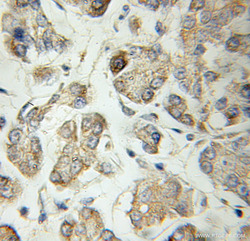Antibody data
- Antibody Data
- Antigen structure
- References [12]
- Comments [0]
- Validations
- Western blot [1]
- Immunohistochemistry [1]
Submit
Validation data
Reference
Comment
Report error
- Product number
- 10954-1-AP - Provider product page

- Provider
- Proteintech Group
- Proper citation
- Proteintech Cat#10954-1-AP, RRID:AB_2190449
- Product name
- Secretogranin III antibody
- Antibody type
- Polyclonal
- Description
- KD/KO validated Secretogranin III antibody (Cat. #10954-1-AP) is a rabbit polyclonal antibody that shows reactivity with human, mouse and has been validated for the following applications: IF, IHC, ELISA.
- Reactivity
- Human, Mouse
- Host
- Rabbit
- Conjugate
- Unconjugated
- Isotype
- IgG
- Vial size
- 20ul, 150ul
Submitted references Agomirs upregulating carboxypeptidase E expression rescue hippocampal neurogenesis and memory deficits in Alzheimer's disease.
Tuning the Size of Large Dense-Core Vesicles and Quantal Neurotransmitter Release via Secretogranin II Liquid-Liquid Phase Separation.
Comparative ligandomics implicates secretogranin III as a disease-restricted angiogenic factor in laser-induced choroidal neovascularization.
Secretogranin III stringently regulates pathological but not physiological angiogenesis in oxygen-induced retinopathy.
Liquid-liquid phase separation facilitates the biogenesis of secretory storage granules.
Function-first ligandomics for ocular vascular research and drug target discovery.
Secretogranin III as a novel target for the therapy of choroidal neovascularization.
Secretogranin III as a disease-associated ligand for antiangiogenic therapy of diabetic retinopathy.
The oncoprotein HBXIP up-regulates SCG3 through modulating E2F1 and miR-509-3p in hepatoma cells.
Secretory sorting receptors carboxypeptidase E and secretogranin III in amyloid β-associated neural degeneration in Alzheimer's disease.
Secretogranin III is an astrocyte granin that is overexpressed in reactive glia.
Secretogranin II binds to secretogranin III and forms secretory granules with orexin, neuropeptide Y, and POMC.
Jiang D, Liu H, Li T, Zhao S, Yang K, Yao F, Zhou B, Feng H, Wang S, Shen J, Tang J, Zhang YX, Wang Y, Guo C, Tang TS
Translational neurodegeneration 2024 Apr 26;13(1):24
Translational neurodegeneration 2024 Apr 26;13(1):24
Tuning the Size of Large Dense-Core Vesicles and Quantal Neurotransmitter Release via Secretogranin II Liquid-Liquid Phase Separation.
Lin Z, Li Y, Hang Y, Wang C, Liu B, Li J, Yin L, Jiang X, Du X, Qiao Z, Zhu F, Zhang Z, Zhang Q, Zhou Z
Advanced science (Weinheim, Baden-Wurttemberg, Germany) 2022 Sep;9(27):e2202263
Advanced science (Weinheim, Baden-Wurttemberg, Germany) 2022 Sep;9(27):e2202263
Comparative ligandomics implicates secretogranin III as a disease-restricted angiogenic factor in laser-induced choroidal neovascularization.
Ji L, Waduge P, Wan W, Tian H, Li J, Zhang J, Chen R, Li W
The FEBS journal 2022 Jun;289(12):3521-3534
The FEBS journal 2022 Jun;289(12):3521-3534
Secretogranin III stringently regulates pathological but not physiological angiogenesis in oxygen-induced retinopathy.
Dai C, Waduge P, Ji L, Huang C, He Y, Tian H, Zuniga-Sanchez E, Bhatt A, Pang IH, Su G, Webster KA, Li W
Cellular and molecular life sciences : CMLS 2022 Jan 10;79(1):63
Cellular and molecular life sciences : CMLS 2022 Jan 10;79(1):63
Liquid-liquid phase separation facilitates the biogenesis of secretory storage granules.
Parchure A, Tian M, Stalder D, Boyer CK, Bearrows SC, Rohli KE, Zhang J, Rivera-Molina F, Ramazanov BR, Mahata SK, Wang Y, Stephens SB, Gershlick DC, von Blume J
The Journal of cell biology 2022 Dec 5;221(12)
The Journal of cell biology 2022 Dec 5;221(12)
Function-first ligandomics for ocular vascular research and drug target discovery.
Rong X, Tian H, Yang L, Li W
Experimental eye research 2019 May;182:57-64
Experimental eye research 2019 May;182:57-64
Secretogranin III as a novel target for the therapy of choroidal neovascularization.
LeBlanc ME, Wang W, Ji Y, Tian H, Liu D, Zhang X, Li W
Experimental eye research 2019 Apr;181:120-126
Experimental eye research 2019 Apr;181:120-126
Secretogranin III as a disease-associated ligand for antiangiogenic therapy of diabetic retinopathy.
LeBlanc ME, Wang W, Chen X, Caberoy NB, Guo F, Shen C, Ji Y, Tian H, Wang H, Chen R, Li W
The Journal of experimental medicine 2017 Apr 3;214(4):1029-1047
The Journal of experimental medicine 2017 Apr 3;214(4):1029-1047
The oncoprotein HBXIP up-regulates SCG3 through modulating E2F1 and miR-509-3p in hepatoma cells.
Wang Y, Cui M, Cai X, Sun B, Liu F, Zhang X, Ye L
Cancer letters 2014 Oct 1;352(2):169-78
Cancer letters 2014 Oct 1;352(2):169-78
Secretory sorting receptors carboxypeptidase E and secretogranin III in amyloid β-associated neural degeneration in Alzheimer's disease.
Plá V, Paco S, Ghezali G, Ciria V, Pozas E, Ferrer I, Aguado F
Brain pathology (Zurich, Switzerland) 2013 May;23(3):274-84
Brain pathology (Zurich, Switzerland) 2013 May;23(3):274-84
Secretogranin III is an astrocyte granin that is overexpressed in reactive glia.
Paco S, Pozas E, Aguado F
Cerebral cortex (New York, N.Y. : 1991) 2010 Jun;20(6):1386-97
Cerebral cortex (New York, N.Y. : 1991) 2010 Jun;20(6):1386-97
Secretogranin II binds to secretogranin III and forms secretory granules with orexin, neuropeptide Y, and POMC.
Hotta K, Hosaka M, Tanabe A, Takeuchi T
The Journal of endocrinology 2009 Jul;202(1):111-21
The Journal of endocrinology 2009 Jul;202(1):111-21
No comments: Submit comment
Supportive validation
- Submitted by
- Proteintech Group (provider)
- Main image

- Experimental details
- HeLa cells were subjected to SDS PAGE followed by western blot with 10954-1-AP(SCG3 antibody) at dilution of 1:500
- Sample type
- cell line
Supportive validation
- Submitted by
- Proteintech Group (provider)
- Main image

- Experimental details
- The Secretogranin III antibody from Proteintech is a rabbit polyclonal antibody to a recombinant protein of human Secretogranin III. This antibody recognizes human,mouse,rat antigen. The Secretogranin III antibody has been validated for the following applications: ELISA, WB, IHC analysis.
 Explore
Explore Validate
Validate Learn
Learn Western blot
Western blot ELISA
ELISA